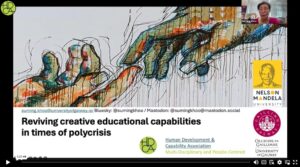…ntail? Online seminars (June to October 2024), followed by a fully funded 3-day in-person workshop at the University of the Free State (UFS) in South Africa (October/November 2024), followed by two online seminars and manuscript development support from Senior African/international academics. ELIGIBILITY CRITERIA: PhD completion within the past 5 years Africa-based ECRs from or resident in CAR, CHAD, MALI, LIBERIA, SIERRA LEONE No more than 1 EN/F…
Search Results for: Viagra Approved Pharmacy ⭐ www.HealthMeds.online ⭐ Buy Viagra 100mg - Cheap Viagra Online
-
-
Reviving Creative Educational Capabilities in Times of Polycrisis
 62 minutes
62 minutes…he idea of an overarching complex of problems, crises, antagonisms, and out-of-control processes on a planetary scale (Morin & Kern 1999, 74, Swilling 2013; 2019). Facets of the current global polycrisis include war, planetary ecological crises, financial crises leading to deeper financialization, persistent and widening economic and social inequalities and deprivation, datafication and the rise of artificial intelligence, and perhaps worst of all…
HDCA Webinar 2025 Education HDCA event/news HDCA Videos -
Artificial Intelligence, Human Development, and Capabilities
 88 minutes
88 minutes…Pramiti Parwani, University of Amsterdam – Global Health, international trade, and intellectual property rights Raul Zambrano, International Development Expert, Technology and Governance, ICT for Development Su-Ming Khoo, Associate Professor / Senior Lecturer, Head of Sociology, School of Political Science and Sociology, Chair, Socio-Economic Impact Research Cluster, Ryan Institute, University of Galway…
HDCA Webinar 2025 Technology, Innovation & Design European Network HDCA event/news HDCA Videos -
Spriros Gangas Deree-The American College of Greece (2024). 'Crisis and the CA: A Systems-Theory Perspective' Paper presented at the annual conference of the HDCA 2024.
-
Christina Schade Universidade Federal da Bahia (2024). 'Planning urban interventions that leave no one behind: Reviewing conversion factors to effectively tackle determinants of inequities' Paper presented at the annual conference of the HDCA 2024.
-
Matthias Kramm Wageningen University Research Oscar Garza-Vázquez Universidad de las Américas Puebla (UDLAP) (2024). 'The common good approach and the capability approach - a critical appraisal' Paper presented at the annual conference of the HDCA 2024.
-
Tobias Schillings (University of Oxford) (2024). 'Spaces of Equality: Universal Healthcare, Trust and Redistributive Preferences' Paper presented at the annual conference of the HDCA 2024.
-
Divvya Bajpai (Delhi School of Business, VIPS-TC) (2024). 'Health Capability during the Covid-19 Pandemic in India' Paper presented at the annual conference of the HDCA 2024.
-
Swati Saxena (Cancer Awareness, Prevention, and Early Detection (CAPED)), Mridu Gupta (CAPED India), Meenu Anand (American Cancer Society), Shaylen Foley (American Cancer Society) (2024). 'Indian women and cervical cancer: Using CA for understanding screening and risk in rural Haryana, India' Paper presented at the annual conference of the HDCA 2024.
-
Dominik Edelhoff University of Duisburg-Essen, Germany (2024). 'Children's Sports and Social Justice - Promoting Children's Capabilities through Transformative Sports Settings' Paper presented at the annual conference of the HDCA 2024.

